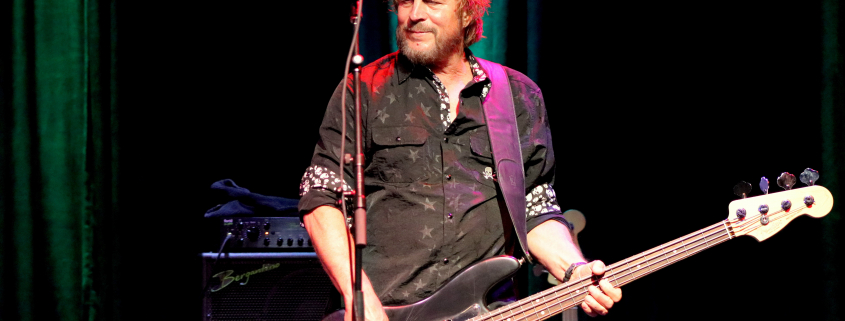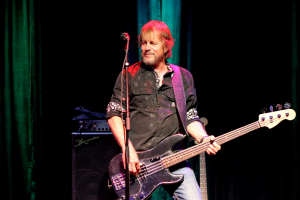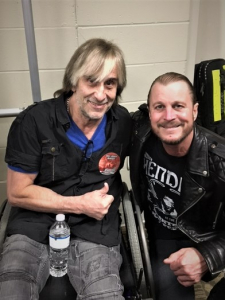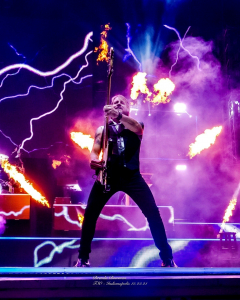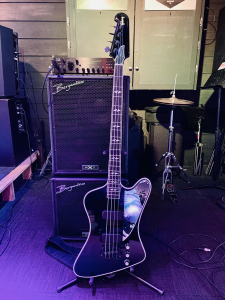Bergantino is proud to welcome Johnny Lee Middleton to our family of artists
Originally hailing from St. Petersburg, FL, Johnny Lee Middleton comes to us by way of world-renowned bassist and entrepreneur, Beaver Felton, CEO of Florida’s Bass Central. Beaver, being an ultra-talented, professional player, knew that Johnny would be a great fit for Team Bergantino. We had a chance to sit down with Johnny to chat about all things bass and his journey through the bass universe.
– Johnny, you’ve known Beaver Felton for over 40 years. How did you two come to meet?
When I first started playing, I would sneak into clubs to see bands play, and Beaver was in one of the best bands in the Tampa Bay area at the time. He was the best bass player around, so I was a fan of his band called Hoochie. When I started gigging out, we would run into each other and he was always nice to me, which was cool because he was the baddest guy in town. We have stayed in touch over the years, and he is my go-to guy if I have any questions about gear.
– Tell us how you started on your bass journey?
I started on trumpet, and in the ninth grade, I joined the jazz band and they set the bass rig behind me. After the first class, I asked the teacher if I could try the bass, and he said yes. He gave me a printout of the notes on the neck of the bass guitar and let me take the jazz bass home. The bass player was a trumpet player as well, so we would switch during the performances. I formed a band called Mariah with the drummer and guitar player from the jazz band and have been in a band in some shape or form since 1978.
– Who are your biggest musical influences?
When I was starting to play, my sister’s boyfriend left some Black Sabbath records at my house, and when I played them, it was life-changing as I had grown up on country music and pop radio. Geezer was my first as well as Phil Lynott and Geddy Lee. I grew up on 70’s music, so all the music of that era influenced my life as a musician.
– Tell us about your band, Savatage, and how it came to be?
I joined Savatage in 1985 when I was 22 years old. They were already signed to Atlantic, so I replaced the original bassist. I rehearsed with the guys for four weeks, and we were off to London to record my first record with the band. It was quite an experience as we were in Trident Studios in the heart of London hanging with the guys from Iron Maiden, Lemmy, and the crew at the St. Moritz, which was a hangout across from the studio.
– How did Trans-Siberian Orchestra emerge?
In 1995, Savatage released an album entitled Dead Winter Dead, which is a rock opera about the war in Bosnia. On that record, we recorded a song called “12/24 Sarajevo,” which is an instrumental track consisting of our version of “Carol Of The Bells,” which our producer Paul O’Neill wanted on the recording but the band did not. After some heated debate, Paul won and a DJ in Tampa Bay picked it up and started playing the song, and it just exploded from there. We really couldn’t do a holiday recording under the name Savatage so Paul started TSO and the rest is history.
– How does the music writing process work in TSO, and will you tour this year?
I am not involved in the writing process when it comes to TSO. Paul O’neill and Jon Oliva, Bob Kinkle, and Al Pitrelli are the guys that are behind the writing process with TSO. We have two TSO touring groups, so when it comes to recording, everybody pitches in so there is not a bass player or a guitar player; it is a combination of players with Al Pitrelli being the MD when it comes to guitar/bass parts.
– Tell us about some of your favorite basses.
As far as basses go, my all-time favorite, and the bass that has recorded every Savatage and TSO note, is my Brooklyn Spector Serial # 511. It is on its third set of frets, third bridge, and second set of machine heads. The pickups have grooves in them from wear and tear, and the mojo is off the chain. Paul O’neill loved it so much he actually located the guy who made the bass and had a replica made. It took some time, but Paul actually had the guitar replicated. Since it is a studio-only bass, I tour with a few Fender Jazz and P Basses and a new Spector X bass I recently received from Spector. It looks like I may be bringing a Spector or two out this year with TSO, so I am excited about that. I also have a Lakland, which was owned by Duck Dunn as it was the prototype for his Lakland model. It had super dead Labella flats on it and smelled like a pipe when I opened the case for the first time. It plays and records like a dream. That would be at the top of the list as well.
– What tone do you strive for in live performances, and how does it fit in the mix?
With TSO, I use the D’Addario flat wound chromes on all my Jazz and P basses as the tone sits better in the mix and flats seem to almost act as a compressor in arenas by tightening up the low end boom I was getting with round wounds, not to mention the fret wear I was getting on my vintage guitars. When you have two keyboard players, you need to stay out of the way or it turns into a mudfest, so flats work great for that gig. When it comes to Savatage, it is a completely opposite set up with round wounds and active pickups for more of a punchy tone with the majority of the songs recorded with a pick on the Spector. I learned how to play as a finger player and never played guitar before playing the bass, so I hate playing with a pick. I had two acrylic finger nails put on my picking hand to get the attack of the pick with the punch of the finger to avoid playing with a pick, and it worked really well on the last two Savatage recordings.
– What are you working on now?
Right now, I am working with Whiskey Stills and Mash out of Hiawasse, Georgia, when I am not touring with TSO. We are a power trio that is a regional band playing originals and covers in the North Atlanta /North Georgia area. We released a CD last year that did well, and we are working on another one now. I really love this band because it is back to where you started and everything is raw. With TSO, everything is perfect, and when you dig it out in the clubs and opening slots for national acts, nothing is perfect. The guys in the band are great players, and we really have a great time. Our new CD will be out around Nov. 1st.
– Tell us about your experience with Bergantino.
I was looking for a rig that I could use in my studio as well as to gig with that is easy to transport and loud enough to use in a live setting. I called my guys at Bass Central, and Bergantino was first on the list so I started my research. After hours of browsing the internet, I chose Bergantino, and I’m glad I did as this rig has everything I need. It works great as a studio rig and can handle volumes needed for live gigs.
– What settings do you use with the Bergantino Forté HP, and how do they benefit your tone?
My settings on my Forte’ HP vary depending on the guitar and the tone needed to fit the song/project I am playing. I am a big fan of the VRC compression and hi and low pass filters as well as the overdrive. I love the Bluetooth pedal option, and the stock firmware works great for me for what I am doing at this time. It sounds great in a live situation at a louder volumeas there is clarity and thump with no break up at volume, which is what I was looking for. I like the grit of the overdrive and the ease of using a Bluetooth connection from the pedal board to amp.
– You are also using the NXT112 and NXT 210, which we commonly refer to as the “322.” How does that setup compliment what you’re trying to project on stage?
I think the 322 is a very versatile rig as it gives you the option of running a small rig to a full-on rock and roll rig that is easy to transport. I have the option of running a 12″ speaker or two 10″ speakers or both! What more could a working bass player want? It works really well in a live rock band setting as every note seems to be audible and nothing is lost in the mix. I have had quite a few house engineers ask me about the rig as they were impressed with the tone out of the DI but not familiar with Bergantino. I have just scratched the surface with this gear and can’t wait to add different firmware and see where it goes.
Please share with us what you do with your off time.
As far as my time off the road goes, I am a fulltime beekeeper and own an apiary in the Smoky Mountains. I raise honey bees from my locally bred stock, and I catch wild honeybee swarms as well as sell honey, queen bees, etc., online and locally. I run about thirty hives, so it keeps me busy when I am not on tour, and I really love working honeybees as it is complicated and physically demanding, which is a lot like being a pro musician. It takes a lot of hard work and dedication to be successful, and that is what life is all about.
Follow Johnny Lee Middleton:
https://www.facebook.com/johnnylee.middleton
https://www.facebook.com/savatage
Bass Central: https://basscentral.com/

